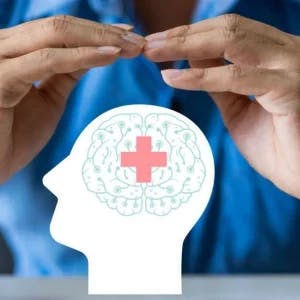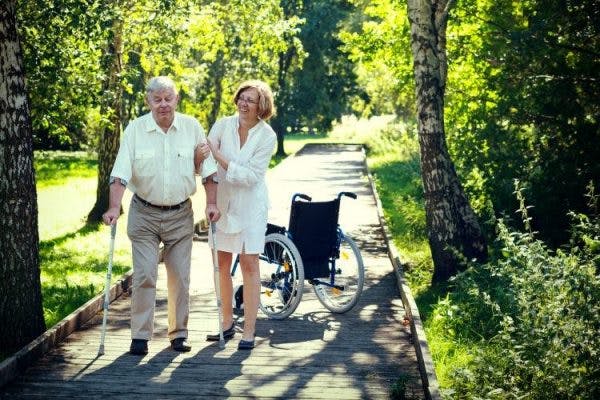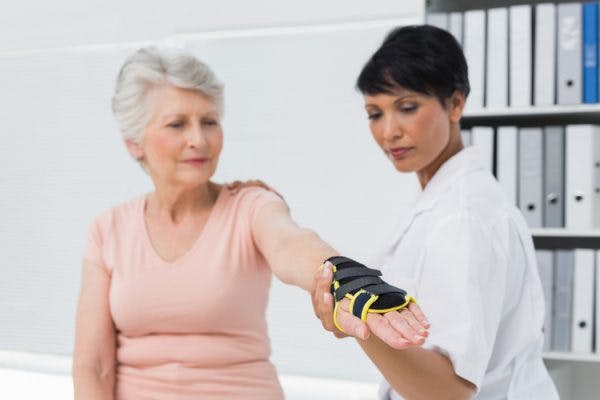Frozen shoulder after stroke can be painful and is also limiting to a survivor’s mobility and overall function. This can take a negative toll on quality of life as survivors navigate the symptoms associated with this condition. Thankfully, there is hope for improvement of frozen shoulder symptoms and recovery of function.
To help you learn more about what frozen shoulder after stroke entails, we will explore the different causes and symptoms in this article. Later, we will review a few of the treatments available to help relieve painful symptoms and promote improvement in shoulder mobility.
What Causes Frozen Shoulder After Stroke?
The shoulder is a dynamic and complicated ball-and-socket joint surrounded by muscle and connective tissue. Frozen shoulder, sometimes referred to as adhesive capsulitis, occurs when this tissue becomes inflamed and tightens around the shoulder joint. This results in restricted and painful movement that limits functional mobility.
Frozen shoulder can happen when the arm is immobilized for a long period. This immobility can be secondary to conditions like hemiplegia or hemiparesis, which refer to paralysis or weakness of one half of the body. Stroke survivors with arm paralysis are particularly at risk of developing frozen shoulder, as tissue irritation and immobility are common. While there are other causes of frozen shoulder, this is the most common reason for its occurrence after stroke.
If survivors affected by paralysis of the arm do not participate in physical therapy, mobility issues can worsen. This is why early rehabilitation is crucial to reduce symptom severity and prevent other complications such as contractures or muscle atrophy. However, frozen shoulder is not always avoidable, even with early rehab intervention.
When a survivor experiences frozen shoulder after stroke, it is treated the same way it’s prevented: with movement. Therapy is often required for patients with frozen shoulder to optimize recovery from this condition. In the next section, we will discuss the different treatments available to promote improvement in pain, mobility, and overall function.
Treatment for Frozen Shoulder After Stroke
Frozen shoulder is a complex condition and can require an extended amount of time to see improvement in symptoms. Progression and recovery generally occur in three stages: “freezing”, “frozen”, and “thawing”. In the “freezing” phase, individuals will experience the most pain and increasing joint stiffness. This can last from 2-9 months and is then followed by the “frozen” phase when the tissue has adhered and is stiff, although this is generally less painful.
During these first two phases, it can be difficult to see improvement in pain and range of motion. When the “thawing” phase begins, however, survivors will notice greater improvements in mobility. This is when therapy is most effective and survivors will see the fastest increase in function. Be sure to work closely with your therapist to create a plan that best meets your needs. To help you get started, let’s discuss some of the most effective treatments for frozen shoulder after stroke:
1. Physical Therapy
Physical therapy exercises for the shoulder and arm are generally the most effective treatment for frozen shoulder after stroke. This treatment gently introduces movement into the shoulder and stimulates the brain to rewire neural pathways between the brain and muscles. By stimulating the brain with exercise, patients spark neuroplasticity, which is the brain’s ability to heal and rewire itself after injury. This is the basic principle behind regaining functions lost due to stroke, such as arm movement.
Stroke patients with a frozen shoulder are often affected by paralysis, which can make exercise even more difficult. Fortunately, patients can begin with passive range of motion exercises during the initial stages of recovery. These exercises can be performed by having a therapist or your opposite limb move your affected shoulder through its full motion. As mobility and active muscle contraction increase, survivors may be able to transition from passive exercises to active exercises.
In addition to slowly improving the shoulder joint’s range of motion, gentle movement can also help with pain control. However, be cautious when attempting to exercise with a frozen shoulder as it is possible to further inflame the shoulder joint and tissues. For this reason, it is important to work under the guidance of a qualified therapist.
2. Occupational Therapy
Another valuable rehab professional who can be involved in frozen shoulder recovery is an occupational therapist. Occupational therapists can provide exercises for the shoulder, wrist, and hand to improve mobility and fine motor control.
Additionally, occupational therapy can help you improve your ability to participate in activities of daily living. This includes tasks such as cooking meals, bathing, dressing, and performing self-care activities. Over time, this can allow survivors to have greater independence at home to improve their quality of life and reduce caregiver burden.
3. Electrical Stimulation
Electrical stimulation is another beneficial treatment for stroke patients experiencing frozen shoulder. This treatment involves sending mild electrical impulses through the skin to the affected muscles. Subsequently, this stimulation can activate the movement of paralyzed muscles and can be an effective treatment for post-stroke paralysis.
There are different types of electrical stimulation available, and each has different benefits. Electrical stimulation (e-stim) can be used to provide pain relief as well as to promote the return of active movement of the shoulder muscles. Additionally, electrical stimulation can be used to help treat shoulder subluxation after stroke. This is because e-stim can promote increased muscle tone to the shoulder musculature to improve shoulder alignment.
Your physical therapist will likely suggest pairing electrical stimulation with exercise. This is because many studies have shown that combining these two treatments leads to more effective results than using electrical stimulation alone. The more you practice engaging your muscles actively, the more mobility and strength you can recover.
4. Botox Injections
Botox is a commonly utilized treatment to reduce spasticity after stroke. However, these injections can also be used to help reduce pain from a frozen shoulder and improve a survivor’s range of motion. Additionally, Botox may be able to help reduce fibrosis or adhesions present in the shoulder joint.
Although results are temporary, Botox can offer enough relief for patients to participate in physical therapy and make improvements in function. Therefore, this treatment may be an excellent option to reduce pain and promote participation in the shoulder exercises necessary for recovery.
5. Shoulder Taping or Arm Slings
Shoulder taping does not treat the root cause of frozen shoulder, but it may provide support for the shoulder joint and relief from painful symptoms. If your shoulder has become subluxed, however, then taping may not be enough to improve your shoulder’s position. In these cases, your therapist may recommend a sling or shoulder brace to provide additional support.
Slings and braces can help support the arm and reduce the gravitational pull on the shoulder socket. This can help minimize aggravation of the shoulder joint for some conditions such as a frozen shoulder. A qualified physical therapist may provide instructions to you or your caregiver for effectively taping the shoulder and can also help you choose a sling. These can be effective additions to the gentle exercises they will likely prescribe.
Which Frozen Shoulder Treatment Is Right for You?
If you are affected by frozen shoulder after stroke, it’s important to talk with your therapist about treatment. This condition generally occurs in three main stages and can require a lengthy recovery. Thankfully, there are treatments available to help increase mobility and reduce pain.
Physical and occupational therapists can guide you through gentle exercises to maximize your range of motion in the early stages of recovery. Then, as you progress into the “thawing” stage of frozen shoulder recovery, your therapists can progress your exercises to improve your mobility and strength. You may also benefit from taping or a sling to reduce the pull of gravity on your shoulder if it has subluxed. Furthermore, if you need additional help with pain management, a therapist can teach you how to apply electrical stimulation correctly.
Frozen shoulder after stroke can be more complex due to possible accompanying secondary effects like hemiparesis or hemiplegia. This is why it is extremely important to work under the guidance of a professional for this condition. Above all, stay consistent with your exercises and continue pursuing recovery. With time you will see improvement and can meet your own unique rehab goals.















